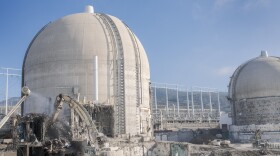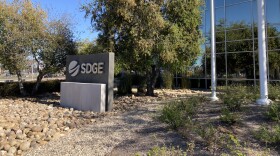Getting people out of their cars is key to -- how does that translate into local community plans? The city of San Diego's investing record amounts of their budget and feeling potholes and working on city streets . This is KPBS Midday Edition. It is Wednesday, September 21. Local community plans are key to laying the groundwork for future growth. Tomorrow the city of San Diego planning commission is said to weigh in on you community plan updates for North Park and Golden Hill. A recent analysis for the city itself says those updated plans will fail some of the cities greenhouse gas and mission goals. Drawing us is Andrew. What about these community plan updates? Why are they in conflict? Those goals are to cut greenhouse gas emissions in half by 2035 and the community plan updates are what the city wants to do to meet those goals. They did that by condensing the density of housing around public transit hubs and that's the idea that more people living and working near public transit in things like bike lanes will mean that your people will depend on cars to get around. The city planning department after a lot of lobbying ultimately agreed to do this analysis on the community plan update and see how effective they're going to be an achieving the goal of getting people out of cars. The analysis found that all of the elements in these CPUs will reduce the percentage of people were commuting iCars but nowhere near the extent that it is needed to meet the goals of the climate action plan. So in a way they're getting us there part way but not far enough. Why are these neighborhoods important? They are in the city's urban core so they are close to downtown to the employment Center there and well connected to downtown. So the expectation is really that these two neighborhoods are among those that will be leading the way and getting people out of cars. The city is quick to point out that the transportation goals are citywide and that the climate action plan has no specific goals for specific neighborhoods. That is true. However, you would expect that North Park and Golden Hill would be sort of leading the way and exceeding the transportation goals in order to make up for other neighborhoods that are less urbanized and further from the downtown job center and where people are still going to have to depend on their cars to get around. Nuchal is the executive director of the climate action campaign. She has been the one who is lobbying the city to conduct these analyses. These are denser, older neighborhoods and close to employment centers and so if we are not offering the community the kind of infrastructure they will need so it is buyable to get to work without taking their car, then that's a problem. Why is the way that people commute to work so vital? Transportation is the largest contributor to greenhouse gas emissions in California. Cars are an immense source of pollution especially in San Diego where we are so car dependent. It is important to note that the transportation is only 15% of the overall greenhouse gas reductions in the climate action plan. 50% is more than enough to make or break the climate plan success. These plans have been in the works for years about eight years before the climate action plan was even past. So could the city take other steps to meet those goals? Absolutely. It will. Some of those strategies are even more controversial than these coming to plan updates like increasing density. There are ideas out there like the parking and reducing the overall parking, supply in neighborhoods so there are a lot of strategies that the city has. The question is are they going to be more politically viable and easy to push through then be community plan updates at the city has now. Has the city itself reacted to these new findings? The city has emphasized that the transportation goals are citywide so these are just two neighborhoods among dozens in the old city and they've also sort of downplayed the significance of the transportation element altogether that they say this is just one piece of the pie in reducing greenhouse gas emissions. It is worth noting that the climate action plan was passed less than a year ago. So if the city in less than a year is already shying away from some of the difficult choices it is going to have to make in order to enforce this that can come back to haunt them in the future. The planning commission has decided to delay taking up the community plan update because of the same reason that it doesn't meet the climate action plan. They see it as a good compromise and tries to meet a lot of different interest and they are hoping that the planning commission on Thursday will recommend approval. The most critical question is whether these plans will get approval as a set or whether those about our law bring to be more aggressive will actually get the city to change them. That could be a lengthy process, but the success of the climate action plan is at stake. It is not just success for San Diego. I think San Diego has tried to make an example of how a city can actually change people's behavior in change are sort of way of life for the better of the environment. So if San Diego fails to fully implement the climate action plan, the consequences can be beyond just here in San Diego. Thank you.
San Diego will fail to meet the ambitious transportation goals of the Climate Action Plan in two key neighborhoods, according to a recent analysis commissioned by the city's planning department.
The analysis looked at the city's updates to community plans in North Park and Golden Hill. The plans are lengthy documents meant to map out how future population and employment growth can become more concentrated to decrease the use of cars.
Both community plan updates are scheduled for a vote at the city's Planning Commission on Thursday.
San Diego's Climate Action Plan, passed unanimously by the City Council in December 2015, requires the city to cut greenhouse gas emissions in half by 2035. A key strategy for accomplishing that goal is to vastly reduce the percentage of people commuting to work by car — from about 83 percent now to 50 percent in 2035.
The city's analysis found the North Park and Golden Hill community plan updates will miss those targets. North Park should see 58.7 percent of people still driving by 2035, while Golden Hill should see 63.7 percent.
A memo signed by Jeff Murphy, director of the city’s planning department, said the analysis does not account for other policies that will be implemented throughout the life of the community plans that will accelerate the shift away from cars. Some examples he included are "additional bicycle and pedestrian improvements whenever street resurfacing occurs, as feasible,... promotion of bicycle and car sharing programs... and, improvements to enhance transit accessibility."
'That's a red flag'
Those additional policies do not impress Nicole Capretz, executive director of the nonprofit Climate Action Campaign. Two of the policies — car sharing and pedestrian improvements — were, in fact, already included in the analysis.
Capretz said she had lobbied the city for months to complete the analysis before sending the community plan updates to the City Council for a vote. She said the numbers for North Park and Golden Hill are alarming.
"These are denser, older neighborhoods, and they are close to employment centers," she said. "So if we, in this future buildout, are not offering the community the kind of infrastructure they're going to need so that it is viable to get to work without taking their car, then that's a problem. That's a red flag."
The transportation goals are citywide, and the climate plan does not offer targets for individual neighborhoods. They also apply only to residents living near existing or planned public transit stops.
But given that some less urbanized neighborhoods are likely to have a tougher time reducing their share of automobile commutes, Capretz said, North Park and Golden Hill should be expected to exceed the citywide goals.
"Some communities need to go under the percent (of commutes by car) required so that we can allow for a buffer," she said. "When we're talking about communities that are in the mid-city area that are close to downtown and, again, close to employment centers — when they're not even getting to the goal, then how are we going to reach that goal?"
The city's analysis found the North Park and Golden Hill community plan updates would exceed the citywide goals of reducing the average distance a resident has to travel to get to work. But Capretz said shorter commutes would not make up for the higher share of people still depending on cars for their transportation.
A city spokesman said in an email that transportation is just one element of the Climate Action Plan, and that the plan allows the city some flexibility in how it achieves the overall goal of reducing greenhouse gas emissions.






